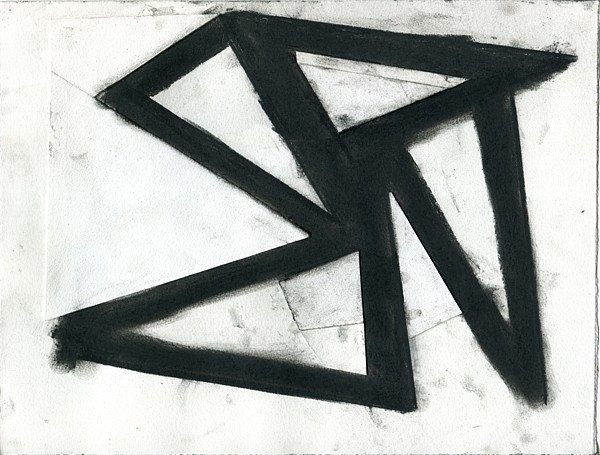
On exhibit: 'Charcoal!' at Schick Gallery at Skidmore College
November 22, 2013 - Amy Griffin for Times Union
What are the results when artists use charcoal as their main medium, instead of as a basic learning tool or preparatory medium? Paul Sattler, director of Skidmore's Schick Gallery answers that question with a new show, "Charcoal!"
The exclamation point belies the subdued, quiet nature of much of the work here. Thirteen artists demonstrate the versatility of the medium with a variety of subject matter, although only one artist depicts figures.
Scott Hunt's narrative vignettes depict scenes that evoke nostalgia. If they have the quality of vintage snapshots, it's because that's what Hunt uses as source material. In "The Fall of Sebastian," a buck shot full of arrows hangs near the back of a car. Looking through the rear passenger window is a child's face, wrenched in anguish. Hunt is one of several artists in the show whose works look almost photo-realistic.
Dozier Bell presents very small but powerfully evocative works that look very much like dreamy photographs. Rendered on Mylar, Bell's drawings depict atmospheric scenes, among them black birds on a wire against a winter sky in "Wire, 1," and birds returning to their roost in a fog, in "Roost."
Like Bell, Anthony Mitri and Emily Nelligan seem to favor charcoal to create atmospheric images. Mitri's urban scenes are completely depopulated. His "Space in the Lower East Side, Manhattan," could be anywhere, but it's a tree-filled refuge in the middle of the crowded city. Light peeks in from behind the trees, but Mitri uses charcoal to summon a moody effect in this and each of his three works here.
Nelligan's drawings are almost all mood and atmosphere. They appear to be seascapes with storm clouds and fog rolling in. The air is made visible as the meeting of sky and sea becomes the starting point for Nelligan to play with the effects created by adding and subtracting charcoal until the scene is on the verge of abstraction.
Several artists harness the power of the white space created by leaving the paper blank in areas. It's easy for charcoal drawings to get swallowed up in smeary gray dust, but clean white space is used to great effect by Susan Hauptman and April Gornik.
In Gornik's drawing "Bower," trees fill the top half of the frame and the ground and background fill the bottom third, leaving trunks snaking through the middle. Gornick utilizes the negative white space between the top and bottom to make the tree trunks pop in dynamic contrast.
Hauptman spares no detail in her still life drawings of a claw-footed bowl filled with flowers. Light reflects off the edges of darker flowers, while one brilliant white flower provides the focal point. In her large drawing, "Still Life (Flowers)," she adds a bit of color — pink flowers float ethereally above a fine porcelain vase.
Other artists in the show use color sparingly, as well. In the case of Dragana Crjak, the use of a pale blue paint in her remarkable site-specific drawing aids in the optical illusion that the drawing is actually three-dimensional. It's not, but drawn directly on the wall the organic shapes, each with a smattering of charcoal below each one to resemble a shadow, fool the eye just the same. The blue also adds to the sense that this abstract drawing suggests some kind of glacial landscape.
Maggie Evans uses a hint of yellow pastel in her charcoal drawings of what look like abandoned corporate break rooms. Tables and chairs and ghosts of tables and chairs sit alone in "Avoiding Conversations" or in groups in "Perpetual Discussion.
The loneliness evoked by Evans' drawings seems to be her motivation, but for Kate Ten Eyck, it's the physical act of mark-making that drives her. Strapping charcoal to eight fingers, she puts down marks before deciding which forms will take hold. She then builds up the forms through layering and erasing of charcoal to arrive at impressively large finished pieces that investigate grid-like structures.
The gallery's press release mentions that charcoal is sometimes "reviled for its messiness." The artists here seem to have overcome this obstacle, if anything exploiting that quality astutely. David Nash, Ken Greenleaf and John Walker are also included.
With an emphasis on contemplative works, "Charcoal!" reveals the range of possibilities that can come from this common and ancient medium.
Amy Griffin is a freelance writer in Delmar.
Back to News
